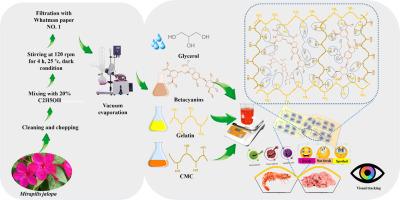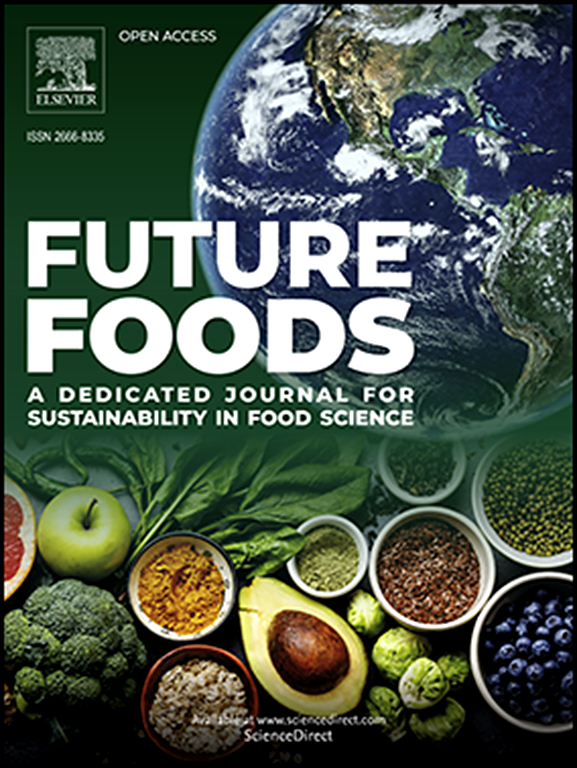用含有贝特矢黄素的明胶/羧甲基纤维素卤色标签监测富含蛋白质食品的新鲜度/损耗率
IF 7.2
Q1 FOOD SCIENCE & TECHNOLOGY
引用次数: 0
摘要
本研究以明胶/羧甲基纤维素薄膜为基础,添加了富含贝壳杉提取物(MJE)的明胶/羧甲基纤维素薄膜,开发了易于使用的包装上的比色标签,用于虾和肉糜的新鲜度跟踪。评估了添加 MJE(2 %、4 % 和 6 %(w/v))对标签的形态、微观结构、光学和功能特性的影响。添加 MJE 后,标签的抗氧化潜力和光阻隔能力得到了一定程度的提高,但机械强度和水阻隔性能却有所下降。标签在不同的 pH 值(2-13)下会发生颜色变化(从粉红色到黄色),这与 MJE 溶液浸入缓冲溶液时的情况相似。负载了 6% (w/v) MJE 的卤化标签对氨的灵敏度最高。这种标签还能检测到 0.01 至 0.1 mg/mL 的氨浓度,并出现从红色到淡黄色的明显颜色变化。当用于监测虾和碎肉的新鲜度时,这种标签会显示出明显的颜色变化,这是由于这些样品在变质过程中挥发性氨的积累和 pH 值的变化造成的。这种标签还具有生物降解性,可在∼21 天内大量分解。因此,我们发现含有 6 %(w/v)MJE 的标签可作为一种可生物降解的卤色指示剂用于食品包装行业,对海鲜和肉类产品进行视觉质量监测。本文章由计算机程序翻译,如有差异,请以英文原文为准。

Freshness/spoilage monitoring of protein-rich foods by betacyanin-loaded gelatin/carboxymethyl cellulose halochromic labels
In the present investigation, easy-to-use colorimetric on-package labels were developed based on gelatin/carboxymethyl cellulose films loaded with betacyanin-rich Mirabilis jalapa extract (MJE) for freshness tracking of shrimp and minced meat. The effect of MJE addition (2 %, 4 %, and 6 % (w/v)) on the morphology, micro-structural, optical, and functional characteristics of the labels was assessed. The addition of MJE indicated dose-dependent improvement of antioxidant potential and light barrier capability of the labels but the reduction of their mechanical strength and water barrier properties. The labels underwent color changes (pinkish-red to yellow) after being exposed to different pHs (2–13), which was similar to the MJE solutions when immersed in buffer solutions. The halochromic label loaded with 6 % (w/v) MJE exhibited the highest sensitivity to ammonia. This label was also capable of detecting ammonia concentrations ranging from 0.01 to 0.1 mg/mL, with a visible color shift from red to pale yellow. When utilized for freshness monitoring of shrimp and minced meat, this label displayed noticeable color changes resulting from the accumulation of volatile ammonia and changes in pH during the spoilage of these samples. The labels were also biodegradable, disintegrating within ∼21 days to a great extent. As a result, we found that a label containing 6 % (w/v) MJE can be used as a biodegradable halochromic indicator in the food packaging industry for visual quality monitoring of seafood and meat products.
求助全文
通过发布文献求助,成功后即可免费获取论文全文。
去求助
来源期刊

Future Foods
Agricultural and Biological Sciences-Food Science
CiteScore
8.60
自引率
0.00%
发文量
97
审稿时长
15 weeks
期刊介绍:
Future Foods is a specialized journal that is dedicated to tackling the challenges posed by climate change and the need for sustainability in the realm of food production. The journal recognizes the imperative to transform current food manufacturing and consumption practices to meet the dietary needs of a burgeoning global population while simultaneously curbing environmental degradation.
The mission of Future Foods is to disseminate research that aligns with the goal of fostering the development of innovative technologies and alternative food sources to establish more sustainable food systems. The journal is committed to publishing high-quality, peer-reviewed articles that contribute to the advancement of sustainable food practices.
Abstracting and indexing:
Scopus
Directory of Open Access Journals (DOAJ)
Emerging Sources Citation Index (ESCI)
SCImago Journal Rank (SJR)
SNIP
 求助内容:
求助内容: 应助结果提醒方式:
应助结果提醒方式:


